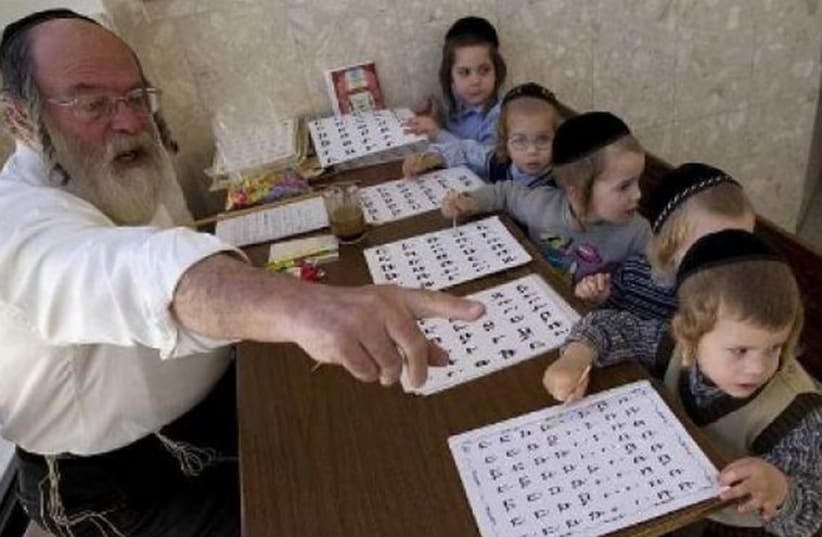Take, for instance, a Central Bureau of Statistics survey published last week which found that 14.5 percent of adult Israelis subjectively felt poor last year. That’s significantly less than the official poverty rate – 19.4% of families and 23.5% of individuals, the highest in the Western world.
The main reason for this discrepancy is the haredim. Only 22% of haredi (ultra-Orthodox) respondents told the CBS they felt poor, despite an official haredi poverty rate approaching 60%, and only 15% of respondents in predominantly haredi Bnei Brak, one of Israel’s poorest cities. That’s because their poverty results from a lifestyle choice that many deem worth the financial sacrifice.
Does this matter? Quite a bit – because if you subtract the people who are poor by choice, Israel’s poverty rate no longer looks anomalously high. If, as seems likely, the 14.5% who said they felt poor approximates the level of involuntary poverty, then Israel’s involuntary poverty rate is still higher than the OECD average (11.3%), but similar to that of Australia and South Korea and lower than that of Spain, Japan and the United States.
In other words, Israel’s anomalous poverty rate isn’t evidence of a uniquely unjust society; its stems from having a large community that’s poor by choice added to an otherwise normal Western poverty rate. Clearly, voluntary poverty is a problem that needs addressing, since its current dimensions make it unsustainable. But it’s a very different problem from involuntary poverty, and must be treated as such. By lumping these two completely distinct problems together, we not only make Israel look worse than it is, we hinder treatment of both problems by obscuring their causes and dimensions.
For another example, consider the persistent Jewish-Arab performance gap on standardized tests, which is usually blamed solely on discrimination. Budgetary discrimination against Arab schools certainly exists, and it does play a significant role in the performance gap. But a study published earlier this month found that even when educational and socioeconomic backgrounds are identical, Hebrew speakers can read their native language faster and more accurately than Arabic speakers can read theirs, due to two distinctive features of the Arabic language.
First, Arabic is diglossic, meaning its oral and written forms are so different that they are effectively two different languages. Thus while Hebrew speakers read in their mother tongue, Arabic speakers read in a second language, which is obviously harder. Second, the physical shape of Arabic letters makes them harder to distinguish than Hebrew letters, so Arabic readers need longer to decipher them and also make more mistakes. Both these factors affect the speed of comprehension.
Thus whenever students take Hebrew and Arabic versions of the same standardized test, the Arabic speakers are at an inherent disadvantage. And that explains part, though obviously not all, of the performance gap.
But to whatever degree this gap is an artifact created by differences in the respective languages, it says nothing about the quality of students’ education or their comprehension of the material. What it does say, as one of the study’s researchers suggested, is that perhaps standardized tests should be adjusted to account for the inherent linguistic differences, so as to give a better picture of what Arab students are really learning. And that problem is completely unrelated to the budgetary one.
Incidentally, studies also show that English speakers read their native tongue faster than Hebrew speakers do, both because the shapes of Hebrew letters are harder to distinguish than those of English letters and because written Hebrew has no vowels. That also explains part – though again, hardly all – of the gap between Israel and other Western countries on international standardized tests: Hebrew- and Arabic-speaking Israelis have an inherent disadvantage compared to countries that use the Latin alphabet, as all European languages do.
A third critical element of the Jewish-Arab performance gap was highlighted by data published last week on pass rates for the 2013 matriculation exams. The wealthy Jewish town of Kochav Yair topped the list, with a pass rate of 93.4%. But in second place – up from third the year before – was the impoverished Druze village of Beit Jann, with a pass rate of 92%. Several other Druze towns also showed impressive improvement, including Isfiya (up 20 percentage points, to 65.3%) and Yarka (up 18 percentage points, to 53.9%).
A 2013 Haaretz article on Beit Jann’s inspiring story noted that at the rate Druze schools are improving, the Druze pass rate will soon exceed the Jewish one. Much of this improvement stems from implementing a special program, which includes additional funding, that the Yeholot association runs in 100 disadvantaged communities – Jewish, Arab, Druze and Bedouin. But Druze educators also credited a sea change in community attitudes toward education.
In short, the Druze have begun viewing education as high priority – something Christian Arabs, whose pass rate already exceeds the Jewish one, have long done, but which many Muslim Arabs still don’t. That’s why pass rates in many Muslim communities still languish around 25% to 35%.
Again, this isn’t to deny the existence of discrimination or the fact that money matters; on average, wealthier communities have higher pass rates than poor ones. But as Beit Jann and other Druze towns show, cultural attitudes and local leadership also matter tremendously.
As with poverty, lumping together three completely distinct educational problems – budgetary discrimination, cultural attitudes and testing bias – and ascribing the entire undifferentiated mass to “anti-Arab discrimination” not only makes Israel look worse than it is, but also hinders treatment of all three problems by obscuring their true causes and dimensions.
The same is true for many other complex social problems. And we would do better at solving all of them is we stopped blaming them entirely on simplistic and inaccurate causes like “economic injustice” or “discrimination.”
Evelyn Gordon is a journalist and commentator. Follow her on twitter here.
